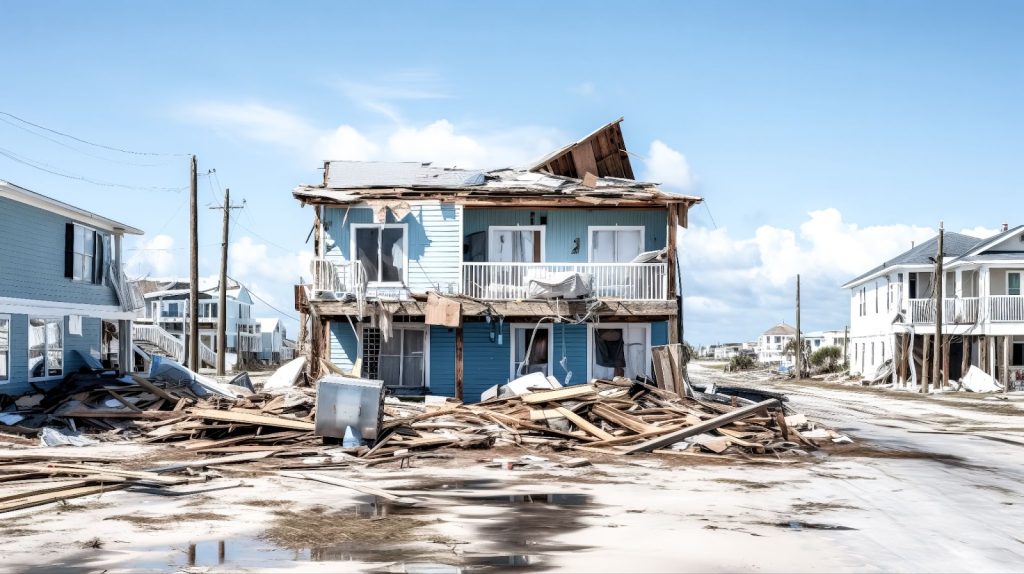Fire Damage Restoration: A Step-by-Step Recovery Process
Experiencing a fire in your home or business is traumatic and sets the stage for a complex fire damage restoration process. As the smoke clears, you’re faced with the daunting task of restoring your property and navigating the intricate world of fire damage claims.
But where do you begin?
This comprehensive guide on fire damage restoration provides a step-by-step approach to reclaiming your space and peace of mind.
From initial damage assessment to how to file a fire damage insurance claim and making crucial restoration decisions, we’ll guide you through every stage of the process.
Whether you’re a homeowner or a business owner, this blog will equip you with the necessary knowledge and strategies to handle fire damage effectively, ensuring you can rebuild safely and efficiently. Let’s start this critical recovery journey together, armed with the right tools to restore your property to its former glory.
What is fire damage?
Fire damage manifests in various forms, often creating a complex situation for property owners. The primary types include structural, smoke, and water damage from firefighting efforts. Let’s take a closer look.
Structural damage
This pertains to the integrity of the building itself. Key components like beams, foundations, and supporting walls can be compromised, posing immediate risks to safety.
Smoke damage
Even beyond the flames, smoke can permeate a structure, leaving behind a persistent odor and a coating of soot residue on surfaces and belongings, which may cause further deterioration if not addressed.
Water damage from firefighting efforts
Ironically, the very methods used to extinguish fires often lead to additional issues. Excess water can soak into materials, fostering mold growth and weakening structural components.
The immediate effects of fire damage range from the obvious, like charred walls and furniture, to the less visible, such as compromised electrical systems.
Left unaddressed, these issues can become severe safety hazards and long-term structural problems. Immediate action is crucial to prevent further damage and ensure the property’s structural integrity and safety.
Psychological impacts of fire damage
Experiencing a fire in your home or business is a physical ordeal that brings profound emotional challenges. The sudden loss and disruption can have lasting effects on one’s mental health. Understanding and addressing these psychological impacts is crucial for holistic recovery.
Trauma and stress
The immediate aftermath of a fire often leaves individuals in shock. As the reality of the damage sets in, stress and anxiety can escalate. Common reactions include sleep disturbances, heightened irritability, and an ongoing sense of fear or dread.
The uncertainty about the future of one’s home or business exacerbates these feelings, creating a stressful period of waiting and uncertainty.
Grieving losses
Fire damage often involves significant losses, from treasured personal belongings to critical business equipment. The loss of items with sentimental value can be particularly distressing.
It’s important to recognize this grieving process and allow yourself or others the space to mourn these losses. Acknowledging the emotional value of what was lost is a crucial step in recovery.
Coping mechanisms
Developing effective coping strategies is vital in managing the psychological impact of fire damage. Here are some methods that can help:
- Seek support: Reach out to friends, family, or professional counselors. Talking about your experiences and emotions is often therapeutic and lessens the burden of recovery.
- Maintain routines: Try to maintain or establish new daily routines. This can provide a sense of normalcy and control amidst the chaos.
- Stay informed: Understanding the steps involved in fire restoration and being actively involved in the process will help mitigate feelings of helplessness.
- Mindfulness and relaxation: Techniques such as deep breathing, meditation, or yoga help reduce stress and improve mental health.
Professional help
The intensity of emotions following a fire sometimes leads to long-term mental health issues, such as depression or post-traumatic stress disorder (PTSD). If symptoms persist or interfere with daily functioning, it may be necessary to seek help from mental health professionals who specialize in trauma.

Creating a positive environment
While the physical rebuilding process is underway, taking steps to create a positive, comforting environment can also aid emotional recovery. Simple actions like decorating temporary living spaces with familiar items or engaging in community activities boost morale and foster a sense of belonging and resilience.
Recognizing and addressing the psychological impacts of fire damage are as important as the physical repair and restoration of the property.
Immediate steps after a fire
Now that we’ve covered what fire damage is and your mental well-being through the process, let’s look at the immediate steps to take after a fire.
In the aftermath of a fire, the immediate steps you take will significantly impact the recovery process. Safety is paramount; ensure the structural integrity of the property before re-entering. Do this by enlisting a fire damage restoration company to conduct a detailed damage assessment, looking out for potential hazards such as weakened floors and walls.
Simultaneously, begin your insurance claim process. Swiftly notify your insurance provider and thoroughly document damage using photos and videos — detailing areas affected by smoke damage, soot residue, and water damage from firefighting efforts. Keep a record of all communications with your insurance agent, who will guide you through the claims process.
Next, secure the property to mitigate further damage. The fire damage restoration company may need to board up windows, install tarps on the roof, and remove excess water using specialized equipment. Prompt action is essential to prevent secondary issues like mold growth.
Planning the restoration process
When planning the fire damage restoration process, the initial step involves carefully assessing the extent of the damage. This damage assessment will help determine whether to embark on a DIY restoration or call in restoration professionals.
| Damage Assessment | DIY Restoration | Professional Restoration |
| Minor smoke residue | Possible | Recommended for guidance |
| Structural damage | Not advised | Strongly recommended |
| Electrical systems | Not advised | Required |
For structural integrity concerns and significant damage from firefighting efforts, it’s best to seek damage restoration services from a certified damage restoration company. These experts have specialized equipment, such as air scrubbers and air movers, necessary for soot removal, smoke damage, and preventing mold growth.
Cleaning and salvaging
Cleaning and salvaging are pivotal in the fire damage restoration process, as they involve meticulous efforts to restore the property and possessions to their pre-damage condition.
When it comes to soot and smoke removal, restoration professionals employ specialized equipment such as air scrubbers and air movers to cleanse the air and surfaces. This step mitigates smoke residue that etches and corrodes if left unaddressed.
Handling water damage is equally crucial, as it often leads to mold growth if not quickly and properly dried out. Experts use dehumidifiers and industrial fans to expedite the drying process, thereby protecting the structure from potential hazards such as weakening or mold proliferation.
As for salvaging possessions, restoration experts conduct a detailed inventory to identify what can and cannot be saved based on the extent of the damage. Items that can withstand cleaning are restored through various techniques, while others beyond repair are documented for insurance claims.
| Salvageable Items | Non-Salvageable Items |
| Glassware | Burned Clothing |
| Metal Utensils | Melted Plastics |
| Some Electronics | Charred Papers/Books |
| Non-Porous Furniture | Smoke-Damaged Mattresses |
In the wake of fire damage, engaging a reputable damage restoration company ensures that each step in the recovery process is handled meticulously, prioritizing both structural integrity and the well-being of those involved.
Dealing with smoke odor
Smoke odor is both uncomfortable and persistent, but addressing it involves certain methods and tools. The first approach is ventilation; open windows and doors to allow fresh air to circulate. Air scrubbers and air movers enhance this process by filtering out smoke particles.
Washing surfaces with appropriate cleaning solutions helps; walls and floors can benefit from a mixture of water and vinegar or commercial soot removal products. Fabrics often require laundering with a combination of detergent and odor-neutralizing additives.
Household items like baking soda and activated charcoal are also effective in absorbing unwanted odors. Placing bowls of these substances around affected areas can gradually reduce the smoke smell.
If the odor persists, it’s time to call in restoration professionals. They have specialized equipment and techniques, such as thermal fogging and ozone treatments, which are designed to tackle the stubborn smoke residue.
When embarking on smoke odor removal, always prioritize safety and be aware of potential hazards. If you’re uncertain about the process or the odor is too intense, consult a fire damage restoration company with expertise in smoke damage restoration for assistance.

Rebuilding and renovating
Rebuilding and renovating after fire damage demand careful planning and execution to ensure a safe and resilient restoration. Key considerations often include choosing fire-resistant materials and possibly altering designs to mitigate future risks. This proactive approach restores the structure and enhances its ability to withstand potential hazards.
When working with contractors, it’s vital to hire reputable teams with extensive experience in damage restoration processes. Verify their credentials, ask for references, and ensure they are well-versed in addressing water damage, smoke residue, and structural damage.
Clear communication and mutual understanding of expectations help maintain a positive contractor relationship and project efficiency.
It’s essential to be realistic about timeline expectations. Structural repairs, soot removal, and addressing damage from firefighting efforts can be lengthy. Obtain a detailed project timeline, including milestones and completion dates.
Regular check-ins with the restoration team will help keep the project on track, and staying flexible can alleviate the stress of unforeseen delays.
Lastly, coordinating with your insurance company from the initial assessment through the insurance claim process is critical. Your insurance agent can guide you in obtaining the necessary documentation and detailed inventories required to ensure comprehensive coverage of renovation expenses.
Financial planning for restoration
One of the biggest concerns for property owners after the immediate aftermath of a fire is managing the financial aspects of the restoration process. Effective financial planning can alleviate some of the stress associated with recovery and ensure that the restoration is thorough and cost-effective.
Here’s how to approach the financial planning for your fire damage restoration:
Setting a realistic budget
Assess the damage
Start by getting a professional estimate of the damage from a reliable contractor or restoration specialist. This will give you a clearer picture of what needs to be repaired or replaced.
Review insurance coverage
Check your insurance policy to understand what is covered and the limits of your coverage. Be sure to note any deductibles that you’ll need to pay out-of-pocket.
Create a budget
Based on the damage assessment and insurance details, create a budget for the restoration. Include a contingency fund for unexpected costs, typically 10-20% of the total estimated costs.
Managing insurance advances
Understand the process
Insurance companies often provide advances against your final claim settlement to start the recovery process. Familiarize yourself with how these advances work and under what conditions they are given.
Document expenses
Keep meticulous records of all expenditures related to fire restoration, as these will need to be presented to the insurance company for reimbursement.
Communicate regularly
Stay in regular contact with your insurance claims adjuster to ensure that your advances are timely and in line with your needs.

Navigating costs and contractor payments
Get multiple quotes
For any restoration work, obtain multiple quotes to ensure competitive pricing. This can also give you leverage when negotiating prices with contractors.
Negotiate payment terms
Work with contractors who are willing to negotiate payment terms. Some may offer payment plans or defer payments until insurance payouts are received.
Scheduled payments
Rather than paying for the entire job upfront, arrange for a payment schedule that aligns with the completion of different stages of the work. This ensures work is completed to satisfaction before the next payment is released.
Long-term financial considerations
Re-evaluate insurance coverage
After experiencing a fire, it’s wise to re-evaluate your insurance coverage to ensure it meets your current needs and to adjust it based on new risk assessments.
Emergency savings
Once recovery is complete, consider building or replenishing an emergency savings fund to prepare financially for any future incidents.
By approaching financial planning with thoroughness and foresight, you can manage the costs associated with fire damage restoration more effectively, ensuring a smoother path to recovery while safeguarding your financial stability.
Handling insurance claims
When dealing with the aftermath of a fire, knowing how to file a fire damage insurance claim is crucial to recovery. Prompt action usually leads to a smoother claims process. Here’s a brief, step-by-step guide to navigate through insurance claims for fire damage:
- Contact your insurance company: As soon as possible, reach out to your insurance provider. Most policies require prompt reporting of damage. Tell them what happened, and they will tell you how to file a fire damage insurance claim.
- Keep records: Document all instances of damage with photographs or videos, and maintain a detailed inventory of destroyed or damaged property.
- Secure your property: This may involve tarping or boarding up to prevent further damage. Some policies mandate these protective measures.
- Assessment by adjuster: An insurance adjuster will visit your property to assess the damage. Be prepared to show your documentation.
- Fill out claim forms: Complete all necessary paperwork your insurance company provides, ensuring accuracy to prevent delays.
- Clean-up and restoration: Begin the clean-up process. Keep all receipts for potential reimbursement.
- Review settlement offer: Analyze the offer from the insurance company to ensure it covers all the losses.
- Negotiate if necessary: If the offer is insufficient, negotiate with your insurance agent. Tips for negotiation include presenting clear evidence of damage and having repair estimates from professional restoration companies.
Always communicate effectively and diplomatically with your insurance agent to ensure you get the full benefit of your policy.

About public adjusters
When navigating the aftermath of fire damage, understanding the role of different types of public adjusters is crucial for effectively managing your insurance claim. Here’s a breakdown of the key differences between an insurance company public adjuster and an independent public adjuster who represents you:
Insurance company public adjuster
An insurance company public adjuster is employed directly by your insurance provider. Their primary responsibility is to the insurance company, not the policyholder.
The main role of these adjusters is to assess the damage to your property and determine the cost of repairs or replacement under the terms of your insurance policy. They are tasked with evaluating the claim on behalf of the insurance company.
Their goal is to process your claim efficiently while also managing the insurance company’s costs.
Independent public adjuster
An independent public adjuster works for you, the policyholder, and not for the insurance company. They are hired independently, and their fees are usually a percentage of the claim settlement.
Independent public adjusters represent your interests in the claim process. They thoroughly assess the damage, help document your losses, and assist in filing and negotiating your insurance claim.
The main objective of an independent public adjuster is to ensure that you receive the maximum amount possible under your insurance policy. They advocate on your behalf, striving to secure a comprehensive settlement that covers all your restoration needs.
Why choose an independent public adjuster?
Choosing to work with an independent public adjuster offers several advantages, especially in complex situations like fire damage restoration. They bring expertise in insurance policies and negotiation, which are invaluable in securing a favorable claim settlement.
Additionally, since they are compensated based on the settlement amount, they are motivated to maximize your claim. This is particularly beneficial if your claim is large or involves significant damage, where the expertise of a knowledgeable adjuster can lead to a substantially higher payout.
Hudson Douglas Public Adjusters is your public adjuster
Are you feeling overwhelmed by the complexity of your fire damage claim and unsure how to ensure you receive the full compensation you deserve?
Hudson Douglas Public Adjusters is here to help. As expert public adjusters, we specialize in handling challenging fire damage claims and advocate relentlessly for your rights as a policyholder. We understand the intricacies of insurance policies and the tactics often used by insurance companies to minimize payouts.
Choosing Hudson Douglas means partnering with a team that stands firmly on your side, using our extensive knowledge and expertise to maximize your settlement.
Don’t navigate this stressful time alone. With Hudson Douglas Public Adjusters, you gain a powerful ally who will meticulously assess the damage, prepare an ironclad claim, negotiate with the insurance company, and fight to secure the compensation needed to restore your property fully.
Visit our website today to learn more about how we can assist you or to schedule a free consultation. With Hudson Douglas Public Adjusters, you can take control of your recovery process and start rebuilding your property and your life.


